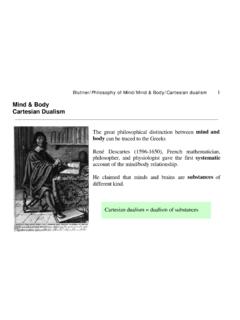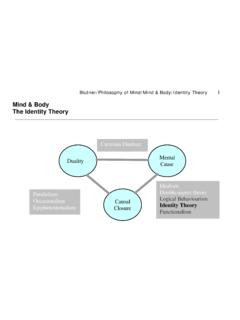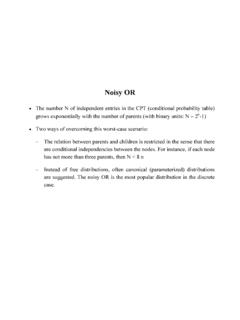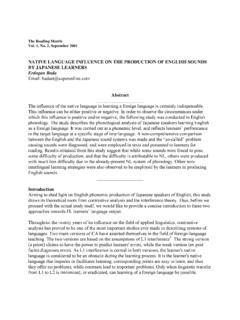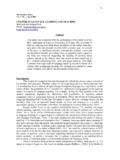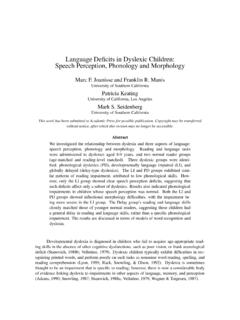Transcription of What is the Sapir-Whorf hypothesis? - Reinhard …
1 What is the Sapir-Whorf hypothesis ?Paul Kay & Willett Kempton (1984)Based on a powerpointpresentation by NT Rusiyanadi2 Outline Introduction Sapir-Whorf hypothesis Study done by Kay & Kempton Conclusions with regards to the Sapir-Whorf hypothesis New evidence and general conclusions3 Introduction In linguistics, the Sapir-Whorf Hypothesisstates that there are certain thoughts of an individual in one language that cannot be understood by those who live in another language . The hypothesis states that the way people think is strongly affected by their native languages. It is a controversial theory championed by linguist Edward Sapir and his student Benjamin whorf .
2 4 Short history First discussed by Sapir in 1929, the hypothesis became popular in the 1950s following posthumous publication of whorf 's writings on the subject. After vigorous attack from followers of Noam Chomsky in the following decades, the hypothesis is now believed by most linguists only in the weak sense that language can have some small effecton thought. 5 Edward Sapir (1884-1939) pronunciation: suh PEER American anthropologist-linguist; a leader in American structural linguistics Author of language : An Introduction to the Study of Speech Born in Lauenberg, Germany. Pupil of Franz Boas, teacher of Benjamin Whorf6 Benjamin Lee whorf (1897-1941) He graduated from the MIT in 1918 with a degree in Chemical Engineeringand shortly afterwards began work as a fire prevention engineer (inspector).
3 Although he met, and later studied with Edward Sapir, he never took up linguistics as a profession. whorf 's primary area of interest in linguistics was the study of native Americanlanguages. He became quite well known for his work on the Hopilanguage. He was considered to be a captivating speaker and did much to popularize his linguistic ideas through popular lectures and articles written to be accessible to lay hypothesis I linguistic relativity: Structural differences between languages are paralleled by nonlinguistic cognitive differences (the structure of the language itself effects cognition) The number and the type of the basic colourwords of a language determine how a subject sees the rain bow8 Sapir-Whorf hypothesis II linguistic determinism = extreme "Weltanschau-ung" version of the hypothesis .
4 The structure of a language can strongly influence or determine someone s World View A World Viewdescribes a (hopefully) consistent and integral sense of existence and provides a theoretical framework for generating, sustaining and applying knowledge The Inuitcan think more intelligently about snow because their language contains more sophisticated and subtle words distinguishing various forms of it, hypothesis III Arbitrariness The semantic systems of different languages vary without constraint. This hypothesis must be tacitly assumed, because otherwise the claim that linguistic Relativity makes is rather undramatic.
5 For each decomposition of the spectrum of the rain bow a natural system of colourwords is possible10 Tests of the Sapir-Whorf hypothesis Two experiments: Experiment 1: Tests whether linguistic relativityexists Experiment 2: Tests whether name strategy can be used as the explanation for the underlying cognitive mechanism in experiment 111 Experiment 1 Distinctions in color terminology English: distinction between blue and green Tarahumara: siy?nameis blue and/or green Subjective distance between colors Discrimination distance ( real scale of psychological distance) Blue-green lexical category boundary (that wavelength at which an equal mixture of green and blue is perceived -based on English speakers)12 Color distinction in English and Tarahumara Chip B Chip C Chip D English green blue Tarahumarasiy?
6 Name 13 Stimuli and method Eight color chips in different shades of green and blue (at two different levels of brightness) Triad technique Three chips at a time are shown which of the 3 chipsis most different from the other 2? 56 triads14 Stimuli green | blue | light | | | dark | G = Lexical Category Boundary (blue-green) 15 Color distinction in English and Tarahumara Chip B Chip C Chip D English green blue Tarahumarasiy?name 16 Question Does the lexical difference result in a distinct judgment of the distances between colors? Which one of the chips A,B,C is the odd one for (a) Speakers of English?
7 (b) Speakers of Tarahumara?17 Results of experiment 1 B, C, D: The distance between B and C was exaggerated by the English speakers, but not (so much) by the Tarahumaraspeakers Chip B is the odd one according to the English speakers; Chip D is the odd one according to the Tarahumaraspeakers18 Estimated triads distances green | blue | | Tarahumara English 19 Conclusions of experiment 1 Kay & Kempton concluded that a Whorfian effect is shown by this experiment: English speakers tended to exaggerate the discrimination of colors close to the lexical category boundary, while Tarahumaradidn t.
8 What cognitive mechanism may have caused this difference?20 Name Strategy Kay & Kempton hypothesized that the English speakers used a name strategy , by discriminating between colors according to their lexical category. , if chips C and D are called blue and chip B is called green , then chip B must be the odd member in this triad21 Experiment 2 To test whether this hypothesis is true, Kay & Kempton conducted a second experiment in which they eliminated the name strategy . If the Whorfian hypothesis isn t found in this experiment, it supports the use of the name strategy in 2 Experiment 2 is quite similar to the first one Differences with experiment 1: Subject was never shown more than 2 colors at once in a triad, but one chip was always shown Subject was asked if the greenness between the first two chips was larger than the blueness between the last two chips.
9 This way it was prevented that he made his own distinctions based on lexical discriminations 21 English and no Tarahumarasubjects participated23 Results of experiment 2 There was no Worfianeffect shown in this experiment. The subjects made distinctions based on the distance between colors and not on the lexical category. The subjects showed the same results as the Tarahumaradid in the first experiment24 Stimuli BCD green | blue | | English 14 7 (no signif. difference) 25 Stimuli ABC green | blue | | English 17 4 26 General conclusions Experiment 1 seems to show a Whorfian effect; English speakers show atendency to discriminate colors based on the lexical category boundary, while Tarahumaraspeakers didn t show this effect.
10 Kay & Kempton hypothesized that a name strategy was the cognitive mechanism that was used by the English speakers. To test this possibility they conducted another experiment. In experiment 2 the name strategy was ruled out. No Whorfian effect was found. 27 New evidence In a brain-damaged patient suffering from a naming disorder, the loss of labels radically impaired his ability to categorise colors(Roberson, Davidoff & Braisby, 1999) A new perceptual colorcategory boundary can actually be induced through laboratory training( zgenand Davies 2002) Categorialperceptionseemsto belanguage-dependent(Roberson, Davies I.)
